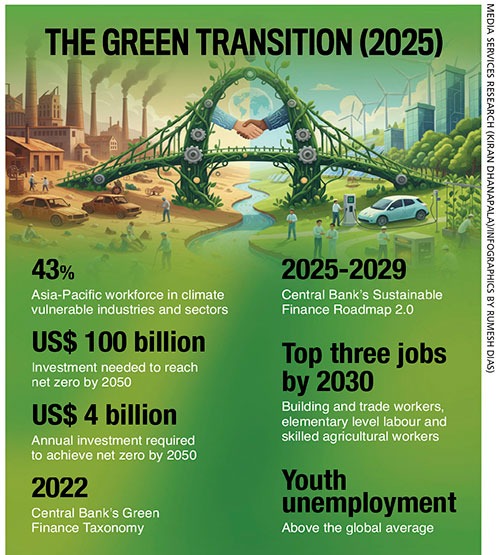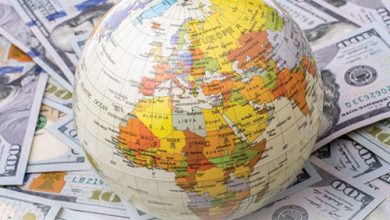THE GREEN ECONOMY
HOW GREEN IS MY VALLEY?
The greening of the national economy – Kiran Dhanapala
Moving towards a green economy presents both opportunities and challenges. A green economy is characterised by low carbon activities compared to fossil fuel driven economic activities. This shift to producing cleaner goods and services is vital for businesses – and indeed, the planet.
Professional services network Deloitte estimates that 43 percent of the workforce in the Asia-Pacific region is employed in industries and sectors that are vulnerable to climate impacts or transitioning to a low carbon economy.
This vulnerability needs to be addressed by greening human resource planning, and developing a strategy that cuts across all sectors and industries.
Such a green transition will need to shift from brown jobs in environmentally intensive activities to cleaner green alternatives.
And the redistributive impact on jobs is extensive. It requires vision, a 360 degree perspective across sectors and industries, and courage if it is to benefit many through the myriad opportunities associated with a green economy.
It also calls for human resource planning, intensifying green vocational training and reallocating labour using market based incentives that reinforce this transition.
Growth sectors in a green transition include renewable energy and low pollution industries that will grow new jobs to compensate for losses in polluting ones. Therefore, education, training, skills development and retraining are needed, to ensure adaptability and inclusivity in the new economy.
The World Bank defines green jobs in three ways: what businesses produce – jobs in environmentally-friendly goods and services; how they produce – using eco-friendly production processes, technologies and inputs; and what workers do – applying green skills to perform tasks such as environmentally-friendly waste disposal in manufacturing.
Sustainability can help define green jobs and different types of work can be made more sustainable – e.g. bakers using organic flour, sustainable packaging and energy efficient ovens. Employers can incorporate sustainable practices by reskilling the workforce and inculcating a sustainability mindset.
There are also green industries with green jobs. The green industry definition examines outputs and identifies green economic activities by using a green taxonomy. China, the EU, Bangladesh and Sri Lanka have developed their own taxonomies, and will use them to analyse green job trends in the future.
At the 2023 UN Climate Change Conference of the Parties (COP28), Sri Lanka estimated that it would need US$ 100 billion in investments to achieve net zero or four billion dollars annually from now until 2050, or five percent of its GDP in 2022.
The Green Finance Taxonomy issued by the Central Bank of Sri Lanka in 2022 aims to guide investments towards green economic activities that are needed to realise the country’s transition to an inclusive and cleaner economy.
Financial institutions are required to report on credit in these categories to track green investments and in time, this tool could be used to track green jobs.
Sri Lanka’s green jobs will also help open up sustainability oriented export markets, particularly in the EU. These jobs will also have to be integrated into plans for critical export diversification – especially the value added sphere.
The National Export Development Plan (NEDP) 2025-29, which is being formulated, will have to include this eventuality in priority sectors at least.
Sustainable finance initiatives are increasing in Sri Lanka, and they will be vital for creating green jobs and generating cleaner economic growth.
The Central Bank’s Sustainable Finance Roadmap 2.0 for the period between 2025 and 2029 addresses both environmental aspects (climate change, natural assets and biodiversity) and social themes such as inclusiveness; micro, small and medium-size enterprises (MSMEs); vulnerable groups; and gender.
Priority areas include climate change mitigation and adaptation, forests and other critical assets, and inclusiveness, all of which have great potential for green jobs. Since the country’s unemployment rate is high among youth and young graduates compared to the wider world, this is an important area for policy making.
The Asian Development Bank (ADB) predicts that technical and medium skill occupations will be in high demand during the green transition. The job groups with high demand are building and related trade workers, elementary level labour in manufacturing, construction and transport, and skilled agricultural workers. Employment trends aren’t expected to be linear.
Technically skilled workers will include wind turbine service technicians, environmental engineers, soil and plant scientists, electric vehicle (EV) technicians and others who will service the green transition.
Since green jobs require more technical skills and a sustainability mindset, it’s necessary to teach the latter across all education subsectors including vocational training. The government must incorporate this type of thinking in its current educational reforms.
Sri Lanka must ensure policy consistency so that it too can transition efficiently.







